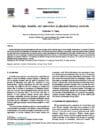Abstract
Literate individuals possess knowledge and skill and can apply these to perform tasks in novel settings. Knowledge is at the heart of physical literacy and provides the foundation for knowing what to do and how and when to perform. In this paper I argue that physical literacy includes not only knowledge for performance but also the ability to apply knowledge and use knowledge for innovation. Scholars since the 1930s have addressed the role of knowledge in physical literacy designing curricula centered on transmitting knowledge through a range of interdisciplinary approaches to physical education. This emphasis on physical literacy curricula continues today in the Science, PE, & Me! and The Science of Healthful Living interdisciplinary curricula.



Responses